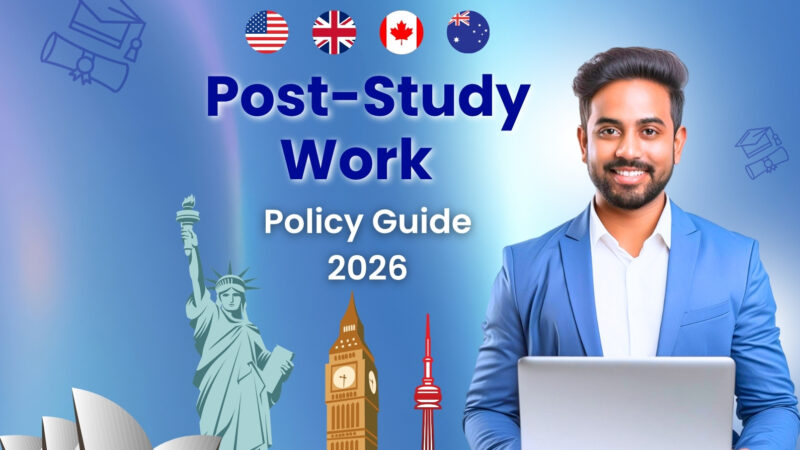
Canada vs Australia: Which Student Visa is Easier to Get in 2026?
Deciding between Canada student visa and student visa Australia for studying overseas? Both countries are top picks for international students—each with its own set of rules, costs, and timelines.
If you’re trying to figure out which is easier to get in 2026, here’s a deep-dive comparison to guide your decision. Along the way, I’ll cover everything from fees and processing time to work rights and post-graduation paths.
What’s New (2025–2026) That Could Affect Visa Ease
Some recent changes to both countries’ visa systems shift the balance a bit:
- Canada has updated its financial requirements for international students (effective September 1, 2025), increasing the proof-of-funds threshold for study permit applicants.
- Australia has revised its visa rules, including the mandatory Confirmation of Enrolment (CoE) for onshore applicants, stricter English test requirements, and student visa fees increasing to AUD 2,000 as of July 2025.
These changes make both countries a bit more demanding in certain respects, especially financially. But “easier” depends a lot on your starting point—how much savings you have, your academic proof, your English language scores, and whether you’re applying from inside or outside either country.
Key Comparison: Canada vs Australia Student Visa
Below is a comparison of core visa-related factors that often trip up applicants or make them hesitate.
FactorCanada (2026)Australia (2026)
Visa/Application Fee: Moderate. Canadian study permits cost considerably less than in Australia. (Exact fee depends on country, but generally much lower than AUD 2,000 High. The Subclass 500 visa fee is AUD 2,000 for primary applicants. Additional fees apply for dependents.
Proof of Funds / Financial Requirement: Increased recently. As of September 2025, minimum proof of funds is CA $22,895 for a single applicant. Also strict. You’ll need funds for tuition, living, travel, health insurance (OSHC), etc. The cost of living requirement is higher, especially in big cities.
English Language & Admission Proofs: Requires proof of English (IELTS, TOEFL etc.), a letter of acceptance from a Designated Learning Institution (DLI), and clean health/criminal records. Some medical checks vary by country.
Need a Confirmation of Enrolment (CoE), which often requires upfront payment of part of tuition, stronger English language test scores under the newer rules, and the Overseas Student Health Cover.
Processing Time: Varies widely. Could be a few weeks to several months, depending on application volume, completeness of documents, and country of origin. Australia’s Subclass 500 visa usually processes within ~61 days if all documents are in order. But delays can happen when caps on enrollment or provider allocations are reached.
Work Rights & Post-Graduation Opportunities Canada is well known for its strong post-study work permit (PSWP) programs, and clearer pathways to permanent residence (Express Entry, Provincial Nominees). Australia also offers post-study work rights (Temporary Graduate Visa—Subclass 485), but requirements depend on your location, course, and sometimes restriction for certain fields. A regional study often gives you more benefits.
Which Visa Seems “Easier” — From a Practical Lens
Putting together all these data points, here’s how things stack up from the point of view of an applicant:
- Canada tends to have lower up-front visa costs and lower proof-of-funds demands compared to Australia. The visa fee is more affordable, and the financial threshold, although recently raised, is still lower than what is typically needed in high-cost Australian cities. If you have a moderate academic profile and good English scores, Canada may feel more accessible.
- Australia has become more rigorous in recent years. Higher fees, stronger documentation (CoE, pre-payments), insurance, and stricter English language requirements make it more demanding. However, if you can meet those stricter criteria, the process is quite streamlined, particularly if you apply fully prepared. For some, the timeline (60-ish days) is appealing vs possibly longer waits for Canada, depending on origin.
So in many cases, students may find Canada student visa somewhat “easier” in 2026—especially those worried about cost. But those who are financially strong, well-prepared, or planning to study in Australia’s regional areas may not find Australia much harder.
Other Important Factors to Consider
Beyond fees and document requirements, here are some other things to weigh in before deciding:
- Cost of Living & Tuition: Australia generally has higher tuition costs in many disciplines in elite universities. Canadian universities vary, with some provinces being more affordable.
- Medical / Health Insurance: Australia mandates OSHC for students. Canada often offers provincial health services depending on where you study; otherwise private insurance may be required.
- Intent & Genuine Student Assessment: Australia uses rigorous checks to ensure genuine students. Canada also assesses intent, but is often judged more on financial stability and academic fit.
- Enrollment Caps & Provider Limits: Australia has introduced caps on the number of international students certain education providers can admit (NPL—New Provider List allocations). If your chosen provider has reached its cap, your application might be delayed or less likely to be accepted promptly.
- Policy Changes & Uncertainty: Both countries are updating policies—visa fees, requirements, financial thresholds. Always check the latest official government sites before starting your application.
SReady to pick your path? Connect Today!
Bottom Line: Canada or Australia?
If you must pick one based purely on ease of obtaining the visa in 2026:
- If you have limited funds, need lower fees, or want fewer upfront requirements, Canada seems the safer bet.
- If you’re financially well-prepared, have strong English scores, acceptance letters, and perhaps prefer Australia for other reasons (climate, lifestyle, course preferences), then Australia student visa is still very viable, but you’ll need to plan more meticulously.

Frequently Asked Questions
Is the visa application fee higher in Australia than Canada?
Yes. Australia’s Subclass 500 fee is AUD 2,000 for primary applicants as of mid-2025. In contrast, Canada’s study permit fees are significantly lower, although still substantial. Yes. As of September 1, 2025, Canada increased the minimum required proof of funds for single applicants to CA $22,895. This is to better reflect living costs and ensure students can support themselves.
Do I need Confirmation of Enrolment (CoE) for Australia?
Yes. The CoE is now mandatory for onshore student visa applications in Australia; you generally must have paid part of the tuition or met certain criteria to receive it. This helps ensure students are genuine and financially able.
How long do I get to work once I finish my studies in each country?
In Canada, post-graduation work permits often last up to 3 years depending on the program. Australia offers post-study work visas (Subclass 485) that vary—some offers are for 2 to 4 years, depending on field, location, and the length of your study.
Which visa is processed faster generally?
Australia’s student visa applications (Subclass 500) tend to have more predictable timelines (~61 days if documentation is in order). Canada’s processing can vary widely depending on the applicant’s country and how complete the application is—some take similar time, others longer.
Book A Free Counseling
Related Blogs
Want to connect with
Our Experts?
We provide keep one to one counselling to
Study Abroad Aspirants









